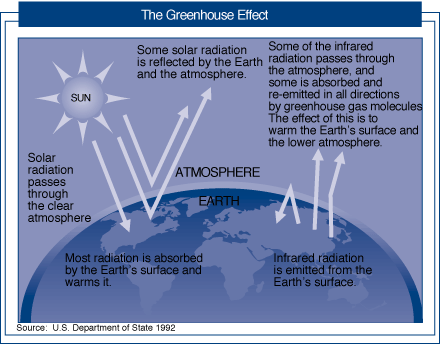|
| |
| |
The Dangers of Carbon Pollution on the Environment - Al Gore The atmospheric concentration of carbon dioxide, the major greenhouse gas directly affected by human activities, has increased by about 30% since the beginning of the pre- industrial era around 1750 because of the combustion of fossil fuels and changes in land- use practices. During the same period of time human activities have also increased the atmospheric concentrations of other greenhouse gases such as methane and nitrous oxide, and regional pollutants such as sulfate aerosols. Increased atmospheric concentrations of greenhouse gases tend to warm the atmosphere, while increased concentrations of aerosols tend, in some regions, to cool the atmosphere. The Earth's climate, which has been relatively stable during the past 10,000 years is now changing. The Earth's surface temperature this century is as warm or warmer than any other century during the six hundred years; the Earth's surface temperature has increased by about one degree Fahrenheit over the last century; and the last few decades have been the hottest this century. In addition, there is evidence of changes in sea level, glaciers are retreating world-wide, and the incidence of extreme weather events is increasing in some parts of the world. Computational models that take into account the observed increases in the atmospheric concentrations of greenhouse gases and aerosols simulate the observed changes in temperature quite well, suggesting that there is a discernible human influence on the Earth's climate. Greenhouse gas concentrations are projected to increase significantly during the next century in the absence of policies specifically designed to address the issue of climate change. For example, carbon dioxide emissions are projected to range from 6 to 36 billion tons of carbon per year in the year 2100: compared to current carbon dioxide emissions of 6 billion tons of carbon per year. Climate models project that the global mean surface temperature could increase another 1.5 to 6.5 oF by 2100: a rate significantly faster than observed changes over the last 10,000 years. Sea level is projected to increase by another 15 - 95 cm by 2100. While the incidence of extreme temperature events, floods, droughts, fires and pest outbreaks is expected to increase in some regions, it is unclear whether there will be changes in the frequency and intensity of tropical storms, cyclones, and tornadoes. The overwhelming majority of scientific experts believe that human-induced climate change is inevitable. The question is not whether climate will change in response to human activities, but rather where (regional patterns), when (the rate of change) and by how much (magnitude). It is also clear that climate change will adversely affect human health (especially increases in vector-borne diseases such as malaria, dengue and yellow fever); ecological systems (changes in the composition and geographic distribution of many ecosystems, especially forests and coral reefs, with likely reductions in biological diversity); and socio-economic sectors, including agriculture (regional disruptions in food production, especially in the tropics and sub-tropics), and human settlements (the loss of land and the displacement of tens of millions of people due to increases in sea level). In summary, human-induced climate change is an important new stress, particularly on ecological and socio-economic systems that are already affected by pollution, increasing resource demands, and non-sustainable management practices; most ecological and socio- economic systems are sensitive to both the magnitude and rate of climate change; successful adaptation to climate change depends upon technological advances, institutional arrangements, availability of financing and information exchange; and developing countries are more vulnerable to climate change than developed countries.


President and First Lady | Vice President and Mrs. Gore |